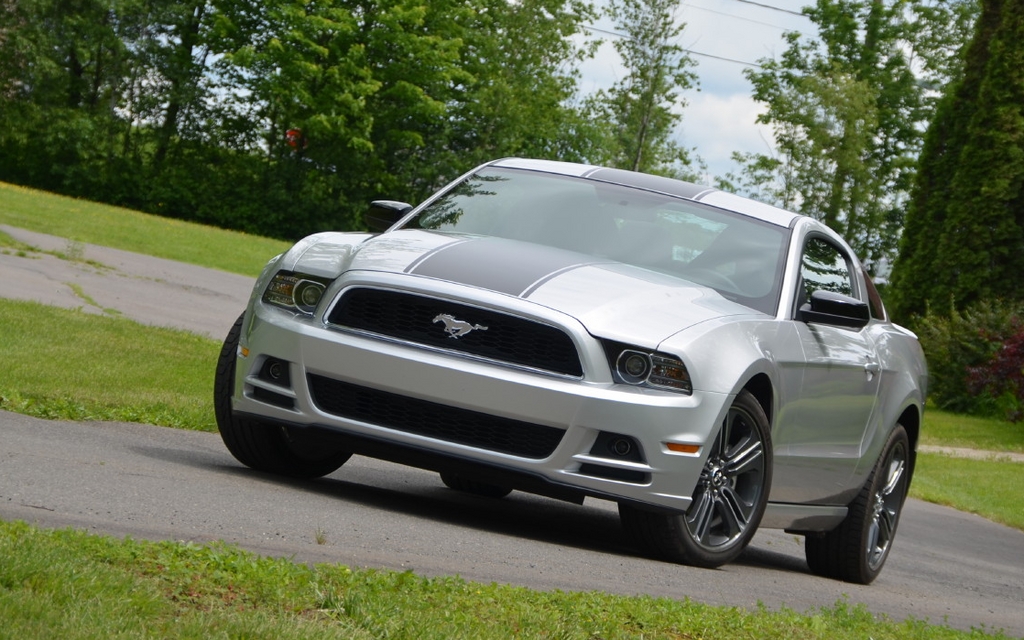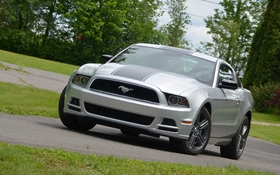Ford Mustang V6: Coupe or cabriolet?

| Strong points |
|
|---|---|
| Weak points |
|
The current Mustang may be nine years old (it was updated in 2005), but you wouldn’t know it by looking at it. Conscious of the lure of its trusty steed, Ford has orchestrated the Mustang’s steady evolution by unveiling more and more powerful or exclusive versions – think of the most recent Shelby GT500 – and by constantly boosting power on the more accessible models. For example, the 2013 Mustang V6 (305 horses/280 lbs-ft) is more powerful than the 2005 V8 GT (300 horses/281 lbs-ft)! Also, the American icon’s style is evolving slowly but surely.
This steady progress explains why people continue to lust after the Mustang, even after all these years. However, you don’t need to opt for the most powerful engine to have fun with Ford’s wild horse.
A few weeks ago, Ford loaned me two V6 versions: a coupe and a cabriolet. Several years had passed since I’d last driven a Mustang and when I got into the coupe, the improved quality of the materials and tighter assembly jumped out at me. Sure, the passenger compartment is still too gloomy with its numerous black and dark grey plastic pieces, but a large band of brushed aluminum now spans the length of the dashboard to lighten the mood. Like any self-respecting sport coupe, the rear and three-quarter visibility isn’t great.
In the wind!
A few weeks later, I received the keys to a Mustang V6 cabriolet. Saying that I’m not a fan of convertibles would be an understatement. In fact, I have always found that the disadvantages of driving with my grey hair blowing in the wind outweigh the advantages. But what wouldn’t a man do to make his daughter happy for her prom? However, I must admit that the Mustang cabriolet is excellent, at least in terms of presentation. With the soft top up, the car is still very nice (although much less so than with the top down, as I’m sure you suspected) and with the top down (it takes 12 seconds) three-quarter rear visibility is greatly improved. Since no cover for the stowed roof is provided with the car, you always have the impression that it isn’t closed properly – even when it is!
The backseats are easier to access in the cabriolet (when the top is down) than in the coupe, but then again, the coupe’s backseats are 8 cm wider, which is noticeably nicer. In front, it’s more of the same. The retractable roof takes up space in the trunk and restricts its capacity. The coupe’s trunk can hold a modest 379 litres, while that of the cabriolet has an even more modest 272-litre capacity.
A pick-up truck engine…
Mechanically speaking, the 3.7-litre V6 that powered the F-150 until last year delivers 305 horsepower and 280 lbs-ft of torque. This engine is equipped with double variable valve timing and direct fuel injection. Although it’s powerful enough to propel the coupe from 0-100 km/hr in 6.6 seconds and from 80-120 km/hr in 5.9 seconds in fourth gear, I didn’t find it particularly enjoyable. Using the high gears wasn’t all that gripping either, especially since it seemed to lack juice after 4,500 rpm. During the weeks that I test drove these vehicles, my average fuel consumption was 11.2 L/100 km with the coupe and 11.4 L with the cabriolet – this matches Ford’s numbers of 11.6 in town. (Everyone knows that to get a good idea of a car’s real average fuel consumption, you have to look at the in-town fuel consumption announced by the manufacturer. In my personal estimation, this works 90% of the time.)
Both Mustangs I tested were equipped with a six-speed manual transmission. Its shifting distance is very short and precise, the resistance of the clutch is just right and the pedals are well suited for heel-toe technique. However, I found first gear a tad long for a sports car. Because of the different differential gear (the transmission gears are identical), “my” coupe’s engine, which had the benefit of the High Performance Package, revved at 1,900 rpm at 100 km/hr in sixth gear while “my” cabriolet’s engine revved at 1,500!
Two types of fun
Once you start to drive, it quickly becomes obvious that the cabriolet doesn’t have as rigid a chassis as the coupe. This news is not exactly earth-shattering, since their use differs as well. A coupe is sportier while a cabriolet, which is sporty in its own right, is more about enjoying the good life. Furthermore, our coupe was equipped with the $3,000 optional High Performance Package, which includes more aggressive tires (Pirelli P Zero Nero255/40ZR19 versus Pirelli P Zero Nero 235/50ZR18 for the cabriolet), a 3.31 limited-slip differential and a few minor esthetic features. The one I drove also had truly exemplary Recaro seats ($500). Believe me, that’s $3,000 well spent!
Both vehicles offer confident handling and minimal roll even though, as you’d suspect, you feel a lot more at ease cornering at high speeds in the coupe because of the rigidity of the chassis and because of the optional High Performance Package. When all of the electronic driving aids are activated, the traction control intervenes very early. On the other hand, when they’re all deactivated, it’s easy to fishtail using the accelerator. The steering isn’t terribly lively (for a sports car) and you get the impression that the front end starts to turn long before the rest of the car follows.
The verdict
Which of these Mustangs is the best? I prefer the coupe, quite simply because I don’t like to be forced to smell the fertilizer spread over fields or the equally bad truck exhaust fumes. But if, for you, a convertible represents freedom and the great outdoors, you might prefer the cabriolet. What is sure is that the Mustang V6 is undoubtedly the best choice – period (along with the Mazda MX-5). It’s my daughter’s favourite anyway.











